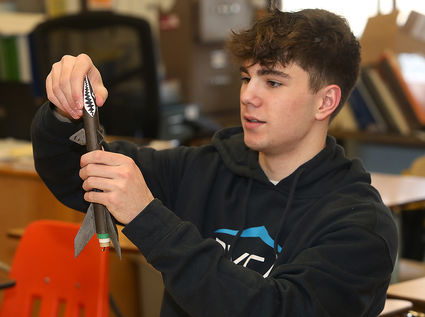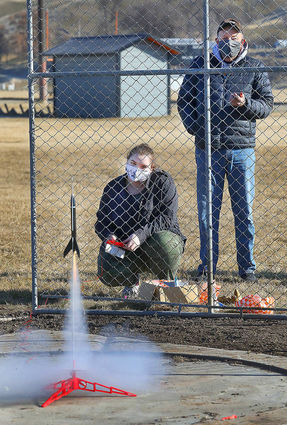Plains students' rockets lift off
March 18, 2021

Ed Moreth
FINAL TOUCHES – Plains High School senior Nathan Feliksa attaches the rocket nose cone after loading the re-entry parachute.
It was over in 6.8 seconds before it took a nose dive into the ground, shattering on impact into several pieces.
The "Shark" showed promise for builder Nathan Feliksa, a senior in Carl Benson's physics class at Plains High School, and one of six students to assemble rockets as part of a class project to help them better understand physics. Feliksa spent three class periods working on his 10-inch long rocket and another two and a half hours hand painting a shark face on the nose cone. He also deviated from the normal rocket appearance by adding three additional inch-long fins near the nose. "Nathan's upper fins actually decreased the laminar flow and that's why it didn't fly straight and true," said Benson, who has had his students conduct a rocket assignment for about 30 of his 36 years at Plains High School.
Feliksa had hopes of the extra fins making the rocket go straighter. Instead, it went up only about nine feet before it started turning, continuing up about 25 feet before spiraling out of control and descending, hitting the ground about 15 feet from the launch pad. "I'm not surprised. I kinda thought it was going to happen," said Feliksa. He also didn't have his engine completely inserted because the glue dried before he could get it in all the way, which Benson believed might have been another reason for the rocket mishap.
The rocket project is part of the physics class on the concepts of impulse and velocity and the relationship between force and momentum, and that for every action there is an opposite reaction. The hands-on approach of building and launching the hobby rockets allows the students to observe what they're learning in the classroom. It also makes what they're learning fun. The students keep records of their launch, weigh the rocket engines with and without the rockets, fill out a worksheet, and take a written test of 10 problem solving questions. Benson said some of the concepts are difficult to grasp. He learned that students' grades improved after he started the rocket exercise.
Last Thursday morning was a clear and cool day with still air, perfect for the launch, said Benson. "The colder temperature is better because the air is more stable and they fly straighter," he added. Each student attached a small mobile altimeter to their rocket to accurately measure its height, although they also had to mathematically determine the altitude. With the altimeter data, the students could get the flight time and determine the rocket's velocity, according to Benson, which they will compare to their calculations from the worksheet. "They are trying to take what they are seeing and applying it to a concept called impulse, which is force x time and then seeing the effects the of momentum of the rocket," said Benson. The teacher said the information between the altimeter and their computations are sometimes different because they don't have a way to measure the rocket drag forces, such as fin placement. Benson said Gumm's rocket started to corkscrew most likely because his fins weren't straight.
The students took turns placing their rocket on the launching pad, which was set up at the school's discus pit, and stood behind the chain link cage as a safety precaution. They counted down before hitting the launch button that sent their machines high into the sky. Most of them went fairly straight, landing within 100 yards of the pad. Feliksa's rocket was the only rocket to crash, which also broke one of the three altimeters. The last launching of the day, Duncan Chisholm's gold-painted rocket landed on the roof of a Clark Fork Valley Hospital building, the second consecutive year for this to happen. Benson said his had the best parachute deployment. The rockets are designed to shoot up with about six seconds of thrust. There is about a five-second delay before the chute is ejected. Inserting the parachute into the fuselage is the second most critical aspect of the assembly process, next to fin placement, which stabilizes the rocket.
Benson was the first to launch with his larger rocket, which had two space shuttles attached. "It flew the best I ever saw," said Benson, who didn't have an altimeter attached, but guessed it went up about 800 feet. He said the shuttles detached and softly glided to the ground. Even with the altimeter, the rockets of Nicolas Gumm, which he named the "Beast," and Chloe French, who spent two hours hand painting a galaxy scene on the fuselage, failed to record the rocket heights.
The first student flight was Skylar Bergstrom, who had the record for the day, reaching a height of 1,180 feet and beating last year's record of 1,146 by Mason Gannarella, whose rocket landed on the hospital roof. Bergstrom had planned to paint flames on her rocket, but instead chose a color to match her pickup truck. The teacher thinks her rocket probably had the straightest course, although he said the rockets of Katrina Hagerman and Chloe French were also fairly straight. "I would say that Skylar probably had the best launch but Chloe had the best landing hands down hitting the picnic table," said Benson.
Hagerman's rocket went up 1,094 feet, according to the altimeter, although she calculated it to be 2,560 feet. Bergstrom also calculated her rocket higher than the reading at a height of 2,093. Gumm mathematically figured that the Beast went up to an estimated 2,595 feet, 9 inches. French calculated her rocket rose to 1,190 feet. Chisholm's rocket was retrieved from the hospital roof that same day, but the altimeter failed to read the height and he had not turned in his calculations.

Ed Moreth
GOING UP – Plains High School senior Katrina Hagerman launches her physics class rocket while teacher Carl Benson times the launch.
The launch took only one class period this year because he had only six students. He usually has double the number and it takes two or three periods. He said this is a competitive class, but in a friendly manner and they like to kid each other. At the end of the school year, Benson plans to give cartificates to the students with the best built rocket and best launch.
Benson uses fun projects with other physics lessons, like creating a "protective" casing for dropping raw eggs off a roof and making airplanes to teach the Bernoulli principle. "I like all of the activities where they have to build something to accomplish a goal. You really get to see the creativity and sometimes frustration when an idea is difficult to accomplish," said Benson, who has one more year for his fun activities because he plans to retire the next year.





Reader Comments(0)